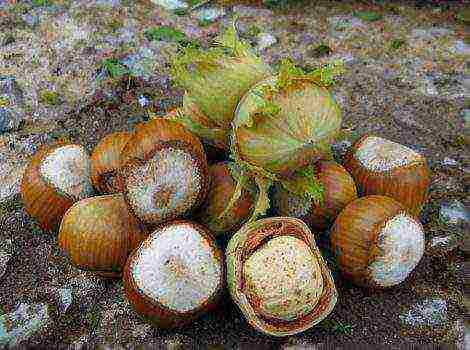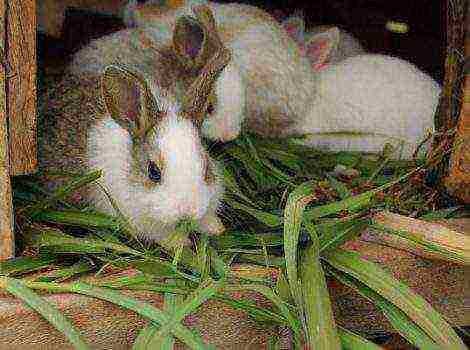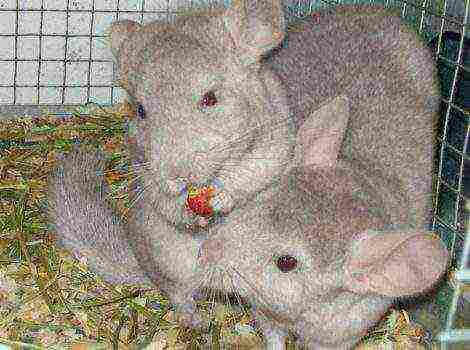Content
How to slaughter and butcher a rabbit?
The purpose of keeping rabbits is to obtain meat and skins. They can only be obtained from a dead animal, and the slaughter must be carried out as humanely for the animal as possible and carefully so as not to deteriorate the quality of the skin.
For many rabbitries, slaughtering rabbits is not an easy task, so this article will help you do it as quickly and bloodlessly as possible, and will also tell you about the correct processing of skins at home.
How to select rabbits to slaughter
When breeding rabbits for meat, the slaughter time is of no fundamental importance. The main thing is that the rabbit has enough weight. Rabbits from four months of age are suitable for slaughter. With proper maintenance, the weight of the animal by this age should reach 3-4 kg. In case of selective slaughter, it is better to leave the largest and healthiest animals for breeding.
It is advisable for connoisseurs of skins to select rabbits born in winter. These animals have the best and highest quality fur. The skins of young animals, as well as rabbits born in summer, are of low cost.
The breeder should know that eared moults are:
- Age - two in the period from 1.5 to 6 months from the date of birth;
- Seasonal - the first usually falls in March-April, the second in September-October.
Determining the end of a rabbit's molt is easy. To do this, gently pinch the eared by the coat. Thick and strong hair holds tight, but if the hairs fall out from a breeze or a light touch, this is a sure sign of a pet's molting.
The best time to slaughter a fur rabbit is December-January. During this period, rabbits do not shed, and the fur is the most dense and valuable.
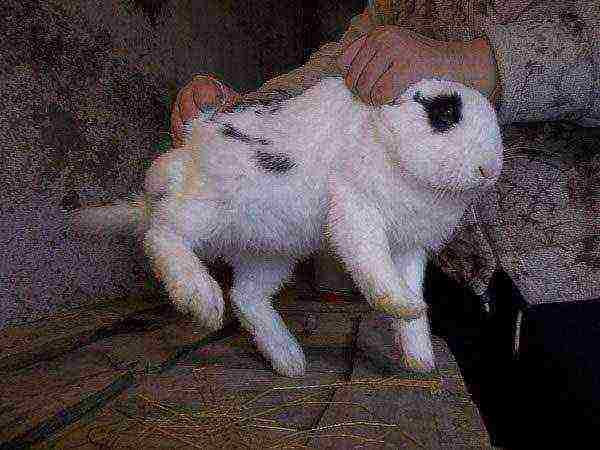
Preparation for slaughter: age for slaughter
The process of slaughtering, skinning and cutting a rabbit should not be delayed. For professionals, this takes about 5 minutes. Therefore, having everything at hand will significantly speed up the process and will not affect the quality of meat and fur.
Preparation for slaughter is as follows:
- The rabbit is seated and not fed or watered for 10-12 hours. This is necessary to cleanse the intestines;
- Before slaughtering, the rabbit should be washed and allowed to dry.
For slaughter, you will need:
- Stick spacer;
- 2 knives. One should be sharp for cutting, the other slightly dull for working with skin;
- Several enameled bowls (pots or other similar containers);
- A basin of clean water and a few rags for wiping your hands;
- Downhole tool, which is selected or manufactured based on the selected method;
Before slaughtering, it is worth watching a video of the correct slaughter and butchering of an animal. If there are acquaintances who keep rabbits, then it is advisable to carry out the first procedure under their supervision and guidance.
A well-made spacer stick will greatly facilitate skinning and cutting of the carcass. Usually it is made of metal or wood.
The length of the flat bar is about 20 cm, along the edges there are sharp and preferably curved upwards along the circumference (at an angle). The total length is about 30 cm. In the middle of the plank there should be a hook for hanging it, as well as a groove clearly indicating the center of the plank.
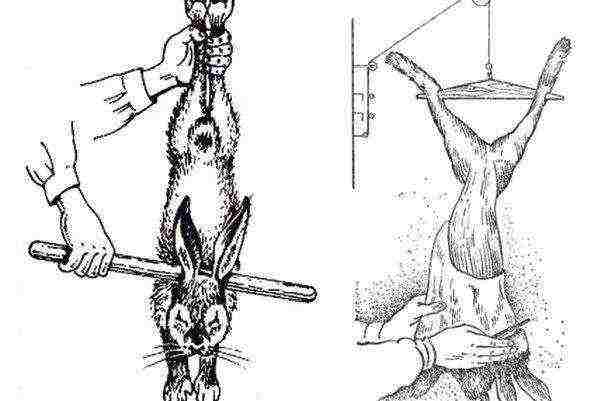
How to slaughter a rabbit: slaughter methods
Now let's look at how to kill a rabbit. In practice, there are six widespread quick, effective and bloodless methods of killing a rabbit. The choice of the most convenient of them is determined by the availability of experience and available tools:
- The bloodless method (jamming) is traditional for our country. - that is, hitting the rabbit on the head with a blunt object. Its advantages are simplicity and no need to purchase complex devices. Death occurs quickly enough, within a few seconds.
To humanely kill the rabbit, it is necessary to lift it on its hind legs, let it calm down and hit the back of the head with a wooden stick. A 40-50 cm long piece of a shovel handle is perfect for this. When hitting, it is important to correctly calculate the force. A strong blow can shatter the skull and complicate the butchering process. Even worse, it's too weak a punch, as the spectacle of a pounding crawl is not for the faint of heart. If this does happen, another blow should be struck.
- The French method is rarely used in our country, but it is very common in Europe.... The rabbit is taken by its hind legs, laid horizontally or held in the air. To kill the crawl, it is necessary to raise it up and shake it sharply. For all the seeming simplicity of this method, it has drawbacks: it takes remarkable strength to shake an animal weighing 7-9 kg with one hand, as well as experience.
- With the help of electricity, the slaughter of rabbits is carried out on large farms. For this, the head of the animal is placed between two electrodes and killed by an electric shock.
The warning does not apply to special electric silencers that are specifically designed for this purpose. The only drawback is that such devices are far from affordable for everyone.
- Another option is breaking the cervical vertebrae. To do this, hold the rabbit with one hand by the hind legs, pressing it to themselves, with the other tightly covering the head. With a sharp turn of the hand to the side, the cervical vertebrae break and the rabbit dies.
- A syringe can also be used to pump air into an animal's ear vein. This technique is called air embolism. It is rarely used at home. Most often used in medical institutions. A significant disadvantage is that death does not occur immediately, and the process of exsanguination does not proceed completely, which worsens the consumer properties of meat and fur.
- Shooting the needle - what a special device resembling a syringe is used for. The needle of the device, penetrating into the brain of the animal, contributes to its rapid and humane killing. It is most effective to pierce the brain on the line from the eye to the opposite ear.
After slaughter, the breeder needs to achieve complete exsanguination of the animal carcass. To do this, the carcass is suspended by its hind legs on a special strut stick. It is necessary to pierce the hind legs with the pointed ends of the stick, spreading them to the distance of the width of the frame. The puncture site should be below the knee joint. Ideal if you manage to get between the bone and the tendon.
To drain the blood, special incisions are made on the animal's nose, or an artery on the neck is cut through the mouth with a thin knife. Sometimes the blood drain is provided by removing the eyeball. It will take 5-7 minutes for the crock to drain. After making sure that the blood has flowed into a previously prepared container, you can proceed to skinning and cutting the carcass.
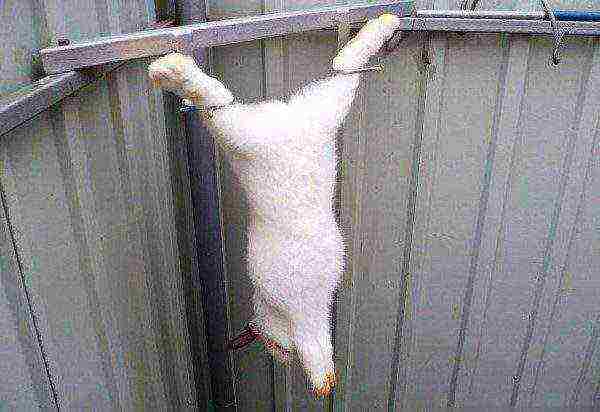
How to skin properly
For quick and easy skinning with a sharp knife, you need to make cuts as follows:
- Above the knee joint of the hind legs in a circle;
- From the edge of the patellar incision, a second incision is made along the inner side of the paw, then along the groin area to an incision on the other paw;
- Front legs (below the knee joint), tail and ears are cut off;
After making the incisions, the skin is carefully, slowly separated from the carcass. Having reached the front paws, they are gently released, after which the skin is removed from the head, although this part of the fur is not of particular value. For a better understanding of the process, you can use the videos, of which there are many on the Internet, or look at the work of a professional.
You may also be interested in rabbit-themed articles:
- How to feed a decorative rabbit?
- Symptoms and prevention of coccidiosis in rabbits.
- Features of keeping rabbits at home.
Making rabbit skin at home for beginners
Now let's look at how to make a rabbit skin at home. For processing, you need a special device - a rule. It is not difficult to make it. For what it is necessary to put together three strips in the form of the letter "A". Moreover, the middle bar should be movable. It is even easier to make a rule from a board 25-30 cm wide. One end is narrowed and rounded. For convenience, you need to have a board with a length of 80 to 100 cm.
Skinning is not difficult. Work with it is carried out in the following order:
- Soaking is done to preliminarily remove dirt and foreign particles. Soaking takes place in a container with warm water (the skins should float freely) at a temperature of 40 degrees. Experienced furriers add a teaspoon of washing powder to 1 liter of water. Formalin (1 ml per liter of liquid) or sulfidine (2 tablets per liter of liquid) can also be added to remove parasites.
It is necessary to soak fresh skins for 3-4 hours.
- After removing dirt and foreign objects from the skin, fleshing is performed, that is, the removal of fat and muscle layer. For this, the skin must be straightened on the board (evenly and without folds). The subcutaneous fat is gently removed with a blunt knife. When fleshing, first start cleaning from the head of the skin, gradually moving to the tail. The edges of the skin are cleaned with movements to the right and left from the middle.
- After fleshing, the skin must be degreased.... For this, the skin is washed by hand with ordinary washing powder, rinsing is performed. In this case, the skin must not be wrung out. The water is allowed to drain, then the skin (the inside of the skin is wiped off with a dry cloth).
- Processing the skin with a solution of salt and acid is called pickling. Its purpose is to remove sticky substances, increase the strength and softness of the product. Pickling is done using:
- Fermentation - soaking the skin for 3-4 days in a solution (for 1 liter of warm water, 200 grams of coarse oatmeal and a teaspoon of yeast);
- Neutralization - carried out for 12-16 hours in solution (for 1 liter of warm water 50-60 ml of concentrated acetic acid plus 2 tablespoons of sodium chloride are added to the entire solution). After neutralization, the skins are kept for two days in a dry place at room temperature.
- Tanning is carried out by applying special tannins... Its task is to improve the consumer qualities of the skin, increase the strength and elasticity. For this, it is necessary to process the flesh several times with a warm decoction of oak or pine bark. The number of times and duration of treatment is determined by the ability of the skin to absorb the decoction.
- After the skin has ceased to absorb moisture, fat is carried out, that is, grease the skin with fat or cream. Fat is necessary to protect the skin from drying out.
- This is followed by the final stage - drying. Why leave the skins stretched for a day.
After completing this sequence of steps, the skin can be safely stored or used to make fur items.
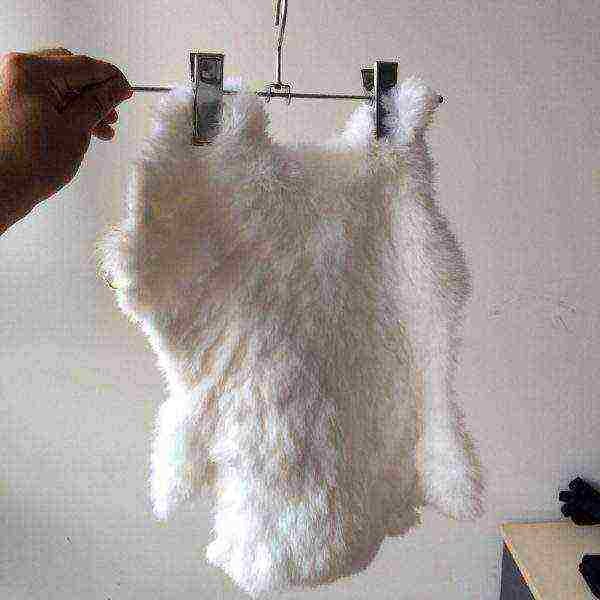
How to cut a rabbit for meat
Now let's talk about how to butcher a rabbit. Butchering a carcass requires an incision in the lower abdomen.This is usually done in one gentle upward motion (assuming the carcass is hanging). Then you need to break the inguinal bones, grasping the hips with both hands and turn them towards the back.
After completing this procedure, they begin to extract the internal organs. Produced in the following order:
- The bladder and ducts are separated;
- For the piece of fur remaining after the skin is removed, the intestines and stomach are pulled out;
- The gallbladder is cut off along with the ducts;
- The liver is removed.
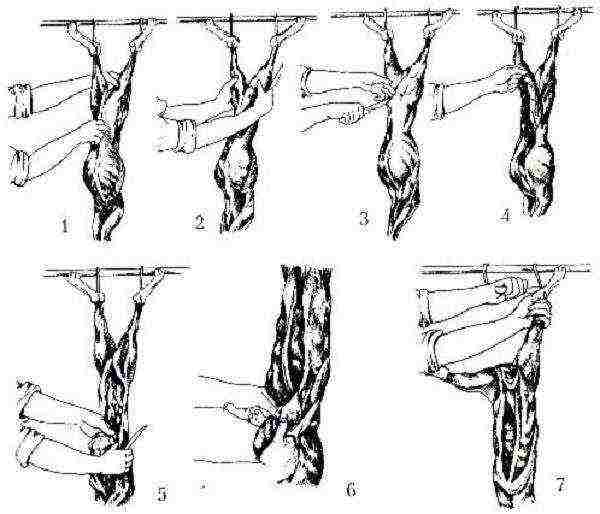
After removing the entrails, the carcass is removed from the spacer. The inedible part of the hind legs and the head are cut off. Next, the rabbit can be cooked, and if necessary, the carcass should be placed in the freezer. The meat of a properly processed rabbit is reddish pink in color with no foreign odors.
As you can see from the presented material, it is not difficult to slaughter a rabbit. However, it requires a large supply of moral strength and practice. And you should immediately decide which method of slaughter to choose.
Finally, a short instructional video on how to slaughter and butcher a rabbit at home for beginners:
